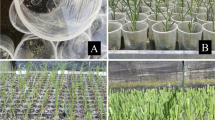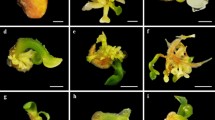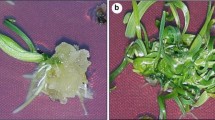Abstract
Six wheat genotypes (three varieties and three whole chromosome substitution lines) were used to analyse the relationship between the initiation of green spots and plant regeneration under short-term tissue culture conditions. The highest percentage of green spot initiation was observed after one week culture on maintenance medium (M-Med.). The calluses producing green spots at the end of the first and second week on M-Med. were highest in regeneration frequency compared to late green spot producing ones. A significant positive correlation between green spot initiation and plantlet regeneration was observed for calluses showing green spots within the first two weeks on M-Med. and was decreased for calluses producing green spots afterwards. The results suggest that by selecting only calluses producing early green spots the experimental efficiency will be increased.
Similar content being viewed by others
References
Ben Amer I M, Worland A J & Börner A (1992) In vitro culture variation of wheat and rye caused by genes affecting plant growth habit in vivo. Euphytica 61: 233–240
Ben Amer I M, Worland A J & Börner A (1995) Chromosomal location of genes affecting tissue culture response (TCR) in wheat. Plant Breeding 114: 84–85
Ben Amer I M, Worland A J & Börner A (1996) The effect of whole chromosome substitutions differing in alleles for hybrid dwarfing and photoperiodic sensitivity on tissue culture response (TCR) in wheat. Euphytica 89: 81–86
Gosch-Wackerle G, Avivi L & Galun E (1979) Induction, culture and differentiation of callus from immature rachises, seeds and embryos of Triticum. Z. Pflanzenphysiol. 91: 267–278
Henry Y, Marcotte J-L & De Buyser J (1994) Chromosomal location of genes controlling short-term and long-term somatic embryogenesis in wheat revealed by immature embryo culture of aneuploid lines. Theor. Appl. Genet. 89: 344–350
Nabors M W, Kroskey C S & McHugh D M (1982) Green spots are predictors of high callus growth rates and shoot formation in normal and in salt stressed tissue cultures of oat (Avena sativa L.). Z. Pflanzenphysiol. 105: 341–349
Nabors M W, Heyser J W, Dykes T A & DeMott K J (1983) Longduration, high-frequency plant regeneration from cereal tissue cultures. Planta 157: 385–391
Purnhauser L, Medgyesy P, Czako M, Dix P J & Marton L (1987) Stimulation of shoot regeneration in Triticum aestivum and Nicotiana plumbaginifolia Viv. tissue cultures using the ethylene inhibitor AgNO3. Plant Cell Reports 6: 1–4
Sears R G & Deckard E L (1982) Tissue culture variability in wheat: Callus induction and plant regeneration. Crop Sci. 22: 546–550
Yang S F & Hoffman N E (1984) Ethylene biosynthesis and its regulation in higher plants. Ann. Rev. Plant Physiol. 35: 155–189
Author information
Authors and Affiliations
Rights and permissions
About this article
Cite this article
Ben Amer, I.M., Börner, A. The relationship between green spot initiation and plantlet regeneration of wheat callus grown under short-term conditions. Plant Cell, Tissue and Organ Culture 50, 67–69 (1997). https://doi.org/10.1023/A:1005855912655
Issue Date:
DOI: https://doi.org/10.1023/A:1005855912655




